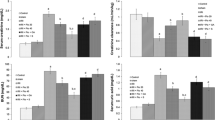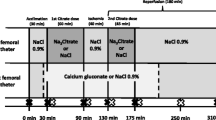Abstract
Dipyridamole (DYP) is an anti-platelet agent with marked vasodilator, anti-oxidant, and anti-inflammatory activity. The present study investigated the role of adenosine receptors in DYP-mediated protection against ischemia reperfusion-induced acute kidney injury (AKI) in rats. The rats were subjected to bilateral renal ischemia for 40 min followed by reperfusion for 24 h. The renal damage induced by ischemia reperfusion injury (IRI) was assessed by measuring creatinine clearance, blood urea nitrogen, uric acid, plasma potassium, fractional excretion of sodium, and microproteinuria in rats. The oxidative stress in renal tissues was assessed by quantification of thiobarbituric acid-reactive substances, superoxide anion generation, and reduced glutathione level. The hematoxylin-eosin staining was carried out to observe histopathological changes in renal tissues. DYP (10 and 30 mg/kg, intraperitoneal, i.p.) was administered 30 min before subjecting the rats to renal IRI. In separate groups, caffeine (50 mg/kg, i.p.), an adenosinergic A1 and A2A receptor antagonist was administered with and without DYP treatment before subjecting the rats to renal IRI. The ischemia reperfusion-induced AKI was demonstrated by significant changes in serum as well as urinary parameters, enhanced oxidative stress, and histopathological changes in renal tissues. The administration of DYP demonstrated protection against AKI. The prior treatment with caffeine abolished DYP-mediated reno-protection suggesting role of A1 and A2A adenosine receptors in DYP-mediated reno-protection in rats. It is concluded that adenosine receptors find their definite involvement in DYP-mediated anti-oxidative and reno-protective effect against ischemia reperfusion-induced AKI.





Similar content being viewed by others
References
Bauerle JD, Grenz A, Kim JH, Lee TH, Eltzschig HK (2011) Adenosine generation and signaling during acute kidney injury. J Am Soc Nephrol 22:14–20
Bonventre JV, Yang L (2011) Cellular pathophysiology of ischemic acute kidney injury. J Clin Invest 121:4210–4221
Brater DC, Harris C, Redfern JS, Gertz BJ (2001) Renal effects of COX-2 selective inhibitors. Am J Nephrol 21:1–15
Buranakarl C, Kitjtawonrat A, Pondeenana S, Sunyasujaree B, Kanchanapangka S, Chaiyabutr N, Bovee KC (2003) Comparison of dipyridamole and fosinopril on renal progression in nephrectomized rats. Nephrology (Carlton) 8:80–91
Chen YC, Chen CH, Ko WS, Cheng CY, Sue YM, Chen TH (2011) Dipyridamole inhibits lipopolysaccharide-induced cyclooxygenase-2 and monocyte chemoattractant protein-1 via heme oxygenase-1-mediated reactive oxygen species reduction in rat mesangial cells. Eur J Pharmacol 650:445–450
Chhabra P, Linden J, Lobo P, Okusa MD, Brayman KL (2012) The immunosuppressive role of adenosine A2A receptors in ischemia reperfusion injury and islet transplantation. Curr Diabetes Rev 8:419–433
Cronstein BN (2004) Adenosine receptors and wound healing. Sci World J 4:1–8
Day YJ, Huang J, Ye H, Li L, Linden J, Okusa MD (2006) Renal ischemia-reperfusion injury and adenosine 2a receptor-mediated tissue protection: the role of CD4+ T cells and IFN- γ. J Immunol 176:3108–3114
Day YJ, Huang L, McDuffie MJ, Rosin DL, Ye H, Chen JF, Schwarzschild MA, Fink JS, Linden J, Okusa MD (2003) Renal protection from ischemia mediated by A2A adenosine receptors on bone marrow–derived cells. J Clin Invest 112:883–891
Day YJ, Huang L, Ye H, Linden J, Okusa MD (2005) Renal ischemia-reperfusion injury and adenosine 2A receptor-mediated tissue protection: role of macrophages. Am J Physiol Renal Physiol 288:F722–F731
Day YJ, Marshall MA, Huang L, McDuffie MJ, Okusa MD, Linden J (2004) Protection from ischemic liver injury by activation of A2A adenosine receptors during reperfusion: inhibition of chemokine induction. Am J Physiol Gastrointest Liver Physiol 286:G285-G293
Eldaif SM, Deneve JA, Wang NP, Jiang R, Mosunjac M, Mutrie CJ, Guyton RA, Zhao ZQ, Vinten-Johansen J (2010) Attenuation of renal ischemia–reperfusion injury by postconditioning involves adenosine receptor and protein kinase C activation. Transpl Int 23:217–226
Eltzschig HK (2009) Adenosine: an old drug newly discovered. Anesthesiology 111:904–915
Ely SW, Berne RM (1992) Protective effects of adenosine in myocardial ischemia. Circulation 85:893–904
Fredholm BB (2007) Adenosine, an endogenous distress signal, modulates tissue damage and repair. Cell Death Differ 14:1315–1323
García-Bonilla L, Sosti V, Campos M, Penalba A, Boada C, Sumalla M, Hernández-Guillamon M, Rosell A, Montaner J (2011) Effects of acute post treatment with dipyridamole in a rat model of focal cerebral ischemia. Brain Res 1373:211–220
Górska AM, Gołembiowska K (2015) The role of adenosine A1 and A2A receptors in the caffeine effect on MDMA-induced DA and 5-HT release in the mouse striatum. Neurotox Res 27:229–245
Grenz A, Bauerle JD, Dalton JH, Ridyard D, Badulak A, Tak E, McNamee EN, Clambey E, Moldovan R, Reyes G, Klawitter J, Ambler K, Magee K, Christians U, Brodsky KS, Ravid K, Choi DS, Wen J, Lukashev D, Blackburn MR, Osswald H, Coe IR, Nürnberg B, Haase VH, Xia Y, Sitkovsky M, Eltzschig HK (2012) Equilibrative nucleoside transporter 1 (ENT1) regulates postischemic blood flow during acute kidney injury in mice. J Clin Invest 122:693–710
Harris RC (2006) COX-2 and the kidney. J Cardiovasc Pharmacol 47:S37–S42
Hasko G, Pacher P (2008) A2A receptors in inflammation and injury: lessons learned from transgenic animals. J Leukoc Biol 83:447–455
Hong Y, Liao WS, Mo RX (2006) Dipyridamole preconditioning protects against ischemia/reperfusion injury of rat liver. Zhongguo Wei Zhong Bing Ji Jiu Yi Xue 18:425–427
Hsieh MS, Zhong WB, Yu SC, Lin JY, Chi WM, Lee HM (2010) Dipyridamole suppresses high glucose induced osteopontin secretion and mRNA expression in rat aortic smooth muscle cells. Circ J 74:1242–1250
Hung CC, Yang ML, Lin MY, Lin HY, Lim LM, Kuo HT, Hwang SJ, Tsai JC, Chen HC (2014) Dipyridamole treatment is associated with improved renal outcome and patient survival in advanced chronic kidney disease. Kaohsiung J Med Sci 30:599–607
Kano K, Nishikura K, Yamada Y, Arisaka O (2003) Effect of fluvastatin and dipyridamole on proteinuria and renal function in childhood IgA nephropathy with mild histological findings and moderate proteinuria. Clin Nephrol 60:85–89
Kapil A, Singh JP, Kaur T, Singh B, Singh AP (2013) Involvement of peroxisome proliferator-activated receptor gamma in vitamin D-mediated protection against acute kidney injury in rats. J Surg Res 185:774–783
Karcz-Kubicha M, Antoniou K, Terasmaa A, Quarta D, Solinas M, Justinova Z, Pezzola A, Reggio R, Müller CE, Fuxe K, Goldberg SR, Popoli P, Ferré S (2003) Involvement of adenosine A1 and A2A receptors in the motor effects of caffeine after its acute and chronic administration. Neuropsychopharmacology 28:1281–1291
Khajehdehi P, Roozbeh J, Mostafavi H (2002) A comparative randomized and placebo-controlled short-term trial of aspirin and dipyridamole for overt type-2 diabetic nephropathy. Scand J Urol Nephrol 36:145–148
Kim HH, Sawada N, Soydan G, Lee HS, Zhou Z, Hwang SK, Waeber C, Moskowitz MA, Liao JK (2008) Additive effects of statin and dipyridamole on cerebral blood flow and stroke protection. J Cereb Blood Flow Metab 28:1285–1293
Kleinbongard P, Heusch G (2015) Extracellular signalling molecules in the ischaemic/reperfused heart - druggable and translatable for cardioprotection. Br J Pharmacol 172:2010–2025
Kuzmin A, Johansson B, Gimenez L, Ogren SO, Fredholm BB (2006) Combination of adenosine A1 and A2A receptor blocking agents induces caffeine-like locomotor stimulation in mice. Eur Neuropsychopharmacol 16:129–136
Laubach VE, French BA, Okusa MD (2011) Targeting of adenosine receptors in ischemia–reperfusion injury. Expert Opin Ther Targets 15:103–118
Lee HT, Emala CW (2000) Protective effects of renal ischemic preconditioning and adenosine pretreatment: role of A1 and A3 receptors. J Am Soc Nephrol 278:F380–F387
Lee HT, Emala CW (2001) Adenosine attenuates oxidant injury in human proximal tubular cells via A1 and A2a adenosine receptors. Am J Physiol Renal Physiol 282:F844–F852
Lee HT, Jan M, Bae SC, Joo JD, Goubaeva FR, Yang J, Kim M (2006) A1 adenosine receptor knockout mice are protected against acute radio contrast nephropathy in vivo. Am J Physiol Renal Physiol 290:F1367–F1375
Li L, Okusa MD (2006) Blocking the immune response in ischemic acute kidney injury: the role of adenosine 2A agonists. Nat Clin Pract Nephrol 2:432–444
Lien YH, Lai LW, Silva AL (2003) Pathogenesis of renal ischemia/reperfusion injury: lessons from knockout mice. Life Sci 74:543–552
Manjunath S, Sakhre PM (2009) Adenosine and adenosine receptors: newer therapeutic prospective. Indian J Pharmacol 41:97–105
Melani A, Cipriani S, Corti F, Pedata F (2010) Effect of intravenous administration of dipyridamole in a rat model of chronic cerebral ischemia. Ann N Y Acad Sci 1207:89–96
Okusa MD (2002) A2A adenosine receptor: a novel therapeutic target in renal disease. Am J Physiol Renal Physiol 282:F10–F18
Okusa MD, Linden J, Huang L, Rosin DL, Rosin DL, Smith DF, Sullivan G (2011) Enhanced protection from renal ischemia: reperfusion injury with A2A-adenosine receptor activation and PDE 4 inhibition. Kidney Int 59:2114–2125
Okusa MD, Linden J, Huang L, Rieger JM, Macdonald TL, Huynh LP (2000) A2a adenosine receptor-mediated inhibition of renal injury and neutrophil adhesion. Am J Physiol 279:F809–F818
Okusa MD, Linden J, Macdonald T, Huang L (1999) Selective A2A adenosine receptor activation reduces ischemia-reperfusion injury in rat kidney. Am J Physiol 277:F404–F412
Peart JN, Headrick JP (2007) Adenosinergic cardioprotection: multiple receptors, multiple pathways. Pharmacol Ther 114:208–221
Prasad D (2006) Update on mechanisms of ischemic acute kidney injury. J Am Soc Nephrol 17:1503–1520
Sachdeva S, Gupta M (2013) Adenosine and its receptors as therapeutic targets: an overview. Saudi Pharm J 21:245–253
Sandhi J, Singh JP, Kaur T, Ghuman SS, Singh AP (2014) Involvment of progesterone receptors in ascorbic acid-mediated protection against ischemia-reperfusion-induced acute kidney injury. J Surg Res 187:278–288
Sharma AK, Linden J, Kron IL, Laubach VE (2009) Protection from pulmonary ischemia-reperfusion injury by adenosine A2A receptor activation. Respir Res 10:58
Soliman M (2011) Nucleoside transport inhibitor, dipyridamole, induced myocardial protection following hemorrhagic shock in ex vivo perfused rat hearts. J Saudi Heart Assoc 23:75–80
Suvarna BS (2013) Adenosine receptors as targets for therapeutic intervention. Kathmandu Univ Med J 41:96–101
Vallon V, Osswald H (1994) Dipyridamole prevents diabetes-induced alterations of kidney function in rats.Naunyn Schmiedeberg's Arch Pharmacol 349:217–222
Vitzthum H, Weiss B, Bachleitner W, Kramer BK, Kurtz A (2004) Gene expression of adenosine receptors along the nephron. Kidney Int 65:1180–1190
Yap SC, Lee HT (2012) Adenosine and protection from acute kidney injury. Curr Opin Nephrol Hypertens 21:24–32
Ye Y, Lin Y, Polo RP, Huang MH, Hughes MG, McAdoo DJ, Manickavasagam S, Uretsky BF, Birnbaum Y (2007) Enhanced cardioprotection against ischemia-reperfusion injury with a dipyridamole and low-dose atorvastatin combination. Am J Physiol Heart Circ Physiol 293:H813–H818
Author information
Authors and Affiliations
Corresponding author
Ethics declarations
The authors followed the guidelines of Committee for the Purpose of Control and Supervision of Experiment on Animals (CPCSEA), Ministry of Environment and Forests, Government of India for housing and experimentation on animals.
Authors’ contribution
APS conceived, designed, and supervised the project. NP performed pharmacological treatments. NP, VM, and MS performed surgery and biochemical studies. DP did histological studies. NP, TK, and APS analyzed the data and wrote manuscript. HSB and APS critically screened the manuscript prior to the submission to journal. All authors approved the manuscript before submission to journal.
Conflict of interest
The authors declare that they have no competing interests.
Rights and permissions
About this article
Cite this article
Puri, N., Mohey, V., Singh, M. et al. Dipyridamole attenuates ischemia reperfusion induced acute kidney injury through adenosinergic A1 and A2A receptor agonism in rats. Naunyn-Schmiedeberg's Arch Pharmacol 389, 361–368 (2016). https://doi.org/10.1007/s00210-015-1206-2
Received:
Accepted:
Published:
Issue Date:
DOI: https://doi.org/10.1007/s00210-015-1206-2




